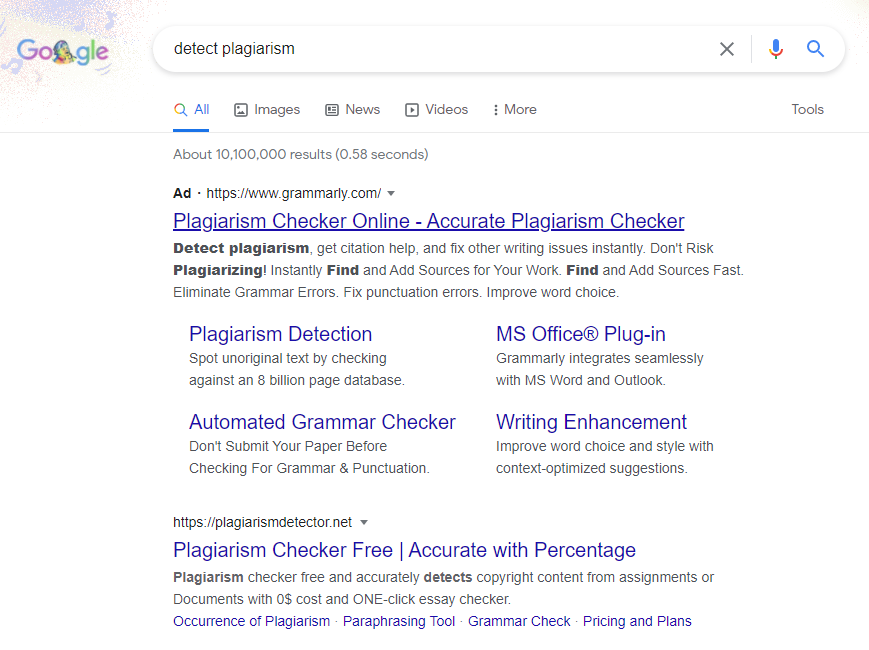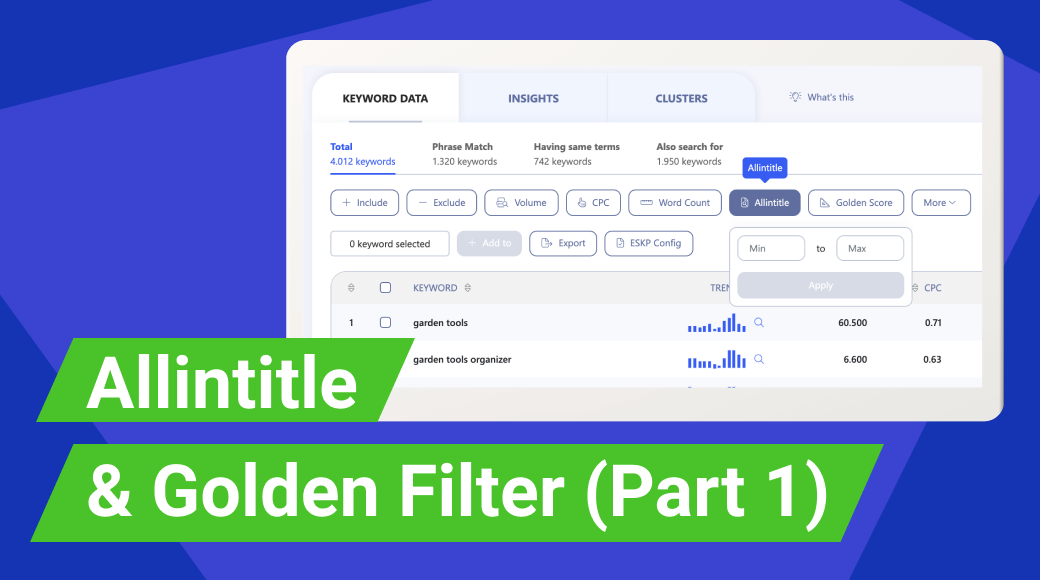Ha Tuan Khang | 12 mins read
If you are an experienced writer with standard SEO knowledge, you’d already be aware of what Allintitle is and how it restricts the result and leads you to what you were looking for. But if you are a beginner, you need to understand how the Allintitle operator works, as it is crucial for your SEO strategy. It will enable you to climb up Google rankings and monetize your content.

I wrote this article to discuss the origin of the Allintitle operator and how it can be used. I will use a simple and in-depth approach to discuss how the operator works as we go into the process of crawling and indexing.
What is Allintitle?
Allintitile is one among the many operators offered by Google to find the articles, webpages and links that have been indexed by a keyword or phrase. When we use the Allintitle operator to search, Google shows results that contain the phrase that you searched for in the title of the webpage.
Consider this example:
Search for “allintitle: detect plagiarism” on Google. The result will contain web pages with the words “detect” and “plagiarism” in their title. To sum it up, the Allintitle operator shows the number of articles or webpages that have been indexed and ranked on the SERP, by Google using specific keywords.
We can use this operator to research the titles of topics that you want to write about. It brings you a more restricted set of web pages that you will be competing with. You can also put this knowledge to use to learn how your competitors are phrasing their headlines using the chosen keywords.
Moreover, you can determine the level of competition your article will face and how it will rank among other web pages that appeared in the search. With this information, you can decide whether it would still be logical to follow your current SEO strategy or pick keywords with lower competition.
In the case of a normal Google search, the operator will only return results that have the search phrase anywhere on the webpage. On the other hand, when you specifically use the Allintitle operator, it will read the title meta tag, generated by the webmaster in HTML. Apart from this, Google will also automatically analyze the content, using their A. I to determine its title, the content itself and how users search for the content. If you run an image search with the Allintitle operator, it shows you files, whose title contains the search phrase. Similarly, if you use the operator in Google News, the search results will contain articles that have the search term in their title.
To learn more about the nature of the Allintitle operator, we will dive deeper into how Google generates search results in general. When we run a search on Google, we expect it to bring up results from its database that are related to our query term, in decreasing the order of response values. This implies that the webpage or article that is most related to the query would appear on top of the search list and the ones that are loosely connected to the term will appear lower in the list. Google also mentions the number of search results it came up with along with the time required to do so.
For example, if we search for “detect plagiarism” on Google:

As seen here, Google can generate 10,100,000 results in a second. Many people think that the number and time are fixed, meaning Google always comes up with the same number of results, no matter what you have searched for. But, in reality, that is not the case. The number of search results keeps on changing up and depends on the query term that you are searching for. This leads us to our next question.
What factors determine the number of search results?
To find the answer to this question, we will have to first understand how Google search functions. Google generates millions of search results under a second. But the process starts with steps like crawling, indexing, ranking, and finally ends by delivering the results to the user. The crawling process can be compared to the Information retrieval model. But Google has integrated advanced algorithms to speed up the crawling, classifying, indexing, and ranking process to bring back innumerable search results to the users within a second.
Let us see how the crawling search engines work with an example of a simplified crawling system.

Image: The process of a simple search engine crawling, fetching, and indexing data.
How does the overview crawl go?
The search engine crawls data according to the following route:
-
- Step 1: Start crawling
- Step 2: Put in the crawl queue
- Step 3: Attempt to fetch, evaluate, and index
- Step 4: Continue to follow the same process with the next links
Remember that the process of crawling, indexing, ranking a page or a website is not solely dependent on Google. It is also affected by the permission of the website owner. We will see more details about it, in the “starting the crawl” and “populating the crawl queue” steps below:

Image: Data crawling process
When starting to crawl, search engines or Google have to go filter, check, evaluate, and prioritize steps as follows:
Step 1: Check robots.txt
Step 2: Check whether the page being crawled is a new crawl or recrawl
Step 3: Determine what type of Crawl mode it is
-
-
-
Continuous crawl mode
-
Scheduled crawl mode
-
Priority crawl mode
-
-
Step 4: Freshness Tuning
-
-
- Crawl Frequently
- Always Force Recrawl
- Recrawl these URL Patterns
-
Step 5: Evaluate the quality of the crawled content to decide whether to index that data or not. If indexed, consider whether it will be fully indexed or partially indexed. And whether the content allows indexing or not. Furthermore, Google does not evaluate just once. Each time it recrawls, Google re-evaluates whether there is an index and whether it should stay or be removed. (Note: when your content has not been indexed, it may be in the queue for Google to re-crawl, or maybe directly disqualified from being indexed).
We discussed in detail how Google as well as other search engines crawl and index. Now you may enquire whether all of this was necessary or not. The answer is yes, it was. This helped us understand that the number of results displayed to the same search is different because the number of articles indexed is constantly changing and billions of websites are crawled during every search.
When you run a search, Google crawls and evaluates which pages or URLs have been indexed and which pages have been not. Thus the number of results per search depends on the number of websites that are live on the internet. There are also certain other factors to consider. A website’s robots.txt may be blocked, or maybe they are actively not indexed by the webmaster, or even be lost. As we can see, it is difficult to imagine the actual number of articles on the internet, the number recorded by Google crawl and the number of websites allowing partial or full indexing is constantly fluctuating.
During the earlier time, Google took considerable time to index through the innumerable web pages and URLs on the internet. But in recent years, Google has brushed its algorithm and search processes to ensure that everything works at top speed and the latency period is minimum. So, now you know why the number of results and the time taken by Google is different every time, even if you run a search with the same keyword.
What is the correct way to use - Allintitle: “keyword” or Allintitle: keyword?
Allintitle operators can be used in two ways. One is with quotes around the keyword and another without quotes. The two ways will produce different results. Use the “search term” to force an exact-match search. Use it to refine results for ambiguous searches, or to exclude synonyms when searching for single words.
Example:
-
- If we use the operator allintitle:” best electric shaver for white men”, the result will contain all of the websites with the exact term “best electric shaver for white men” in the title
- If you use the operator without the quotes allintitle: best electric shaver for white men, the result will show links containing “best”, “electric“, “shaver”, “for”, “white” and “man”.
- So if you don't use the quotes, the results for allintitle: best white electric shaver for men and allintitle: best electric shaver for white men will be the same. This would not make sense because the two search terms have different meanings.
- If we use the operator allintitle:” best electric shaver for white men”, the result will contain all of the websites with the exact term “best electric shaver for white men” in the title

Results of allintitle: best electric shaver for white men

Results of allintitle: best white electric shaver for men
From the above example, we can see that using quotes will generate more accurate results than without using them. It is why the algorithm used to determine Golden Keyword prioritizes Allintitle operators with quotes.
Ref: http://www.googleguide.com/advanced_operators_reference.html.
How to use Allintitle in SEO
We could directly use Allintitle to check if a keyword is competitive or not. But we were faced with a problem when testing many projects. We needed to look into all the keywords with high commercial value that will help to increase sales and profit but will also have the lowest competition. This way we could optimise the results in terms of cost and benefit while working with fixed resources.
WriterZen offers a way to work over this problem, by calculating the Golden Score Value. This score reflects the highest commercial efficiency and lowest competition.

Look forward to the second part for an in-depth explanation of how WriterZen calculates the Golden Score value and more on how you can utilize it for keyword planning.
________________
Ha Tuan Khang
Co-founder of WriterZen









